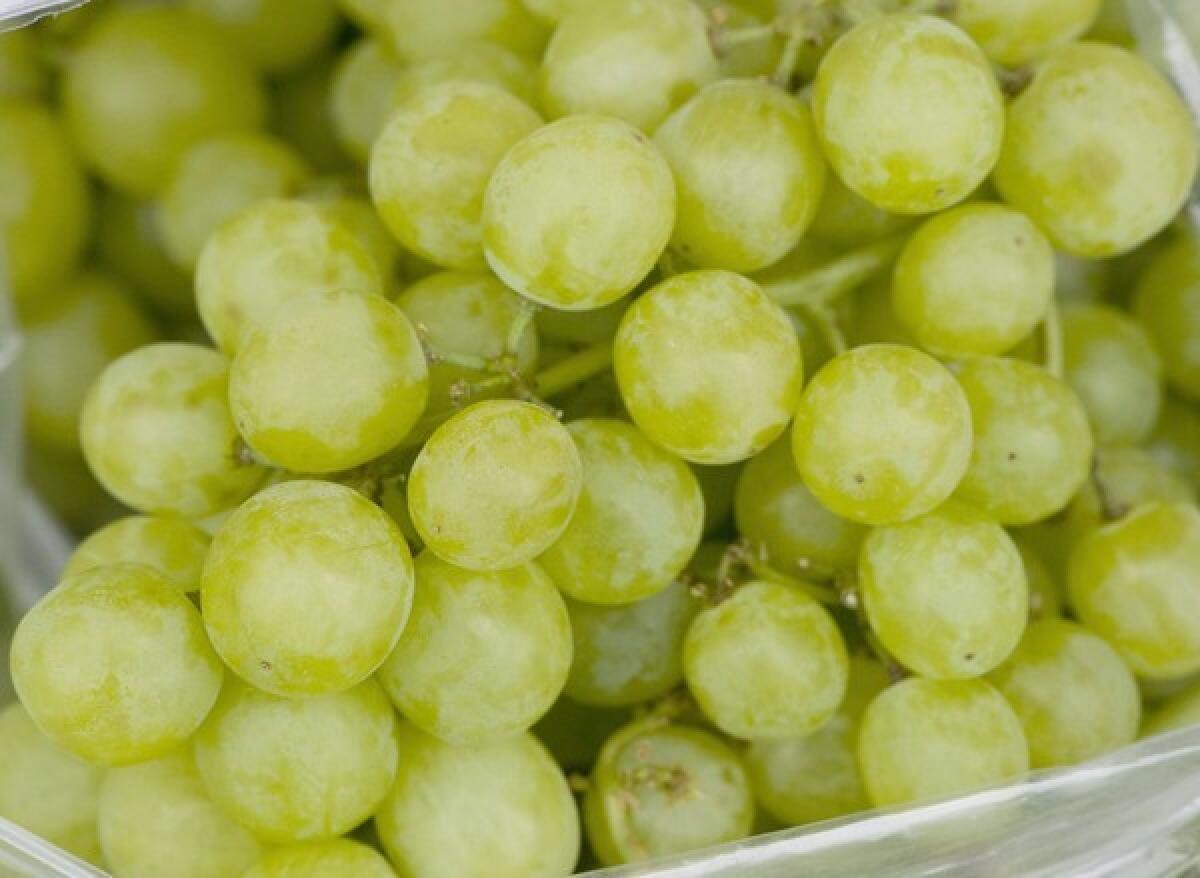Market Watch: Flavorful grapes are coming to farmers markets

Table grapes are readily available year-round at supermarkets, and if you’re just looking for a juicy, healthy snack, you can do perfectly well there. But if you’re looking for grapes with flavor, the best source is farmers markets, where the season for table grapes from the earliest part of the main growing area, the southern San Joaquin Valley, has just started, and vendors increasingly are offering specialty varieties to appeal to diverse tastes.
PHOTOS: At the farmers market.
Most commercial grapes, like the red, round, crunchy Flame Seedless, are sweet but bland — what’s called “neutral flavored” in the trade. If you want something with more flavor, several newer varieties are worth exploring, all bred by David W. Ramming and Ronald E. Tarailo of the U.S. Department of Agriculture, the Lennon and McCartney of grape breeders.
First, even neutral-flavored grapes with dark skins offer a touch of astringency that translates to a spicier, more interesting taste. Historically, seedless black grapes were only available somewhat later in the season, but a USDA variety introduced in 1994, Black Emerald, can be harvested earlier. Scott Farms of Dinuba has just started selling good examples, firm, though still modest in size, at the Santa Monica Wednesday market.
Second, Eastern varieties like Concord provide rich, delicious fruity flavor, derived from a compound called methyl anthranilate, which imparts to wild strawberries their characteristic aroma, and a related chemical, ortho-amino acetophenone, which is also found in the scent glands of certain weasels and foxes; this may explain why early settlers described native grape flavors as “foxy.”
Concord is the classic of this type, but it does not flourish in California, and its seeds and thick, tannic, slippery skin are not for everyone. Thomcord, a cross of Thompson Seedless and Concord introduced in 2003, preserves the best attributes of both parents in a variety adapted to California. It offers a pleasant Concord-like flavor, less strong than Concord itself, but has a thinner, milder skin and is virtually seedless (a small “seed trace” is noticeable in some berries).
Thomcords grown in most areas of the San Joaquin Valley won’t be ripe for another week or two, but Murray Family Farms, which started selling the variety last week and will have it for a few weeks more, grows in Arvin, at the valley’s southeastern edge. Here everything comes together for an early harvest: The vines are on sandy ground, facing west, and above the fog in the winter, so they get a quick start in growing.
Grapes at farmers markets are often smaller than those from commercial growers, who typically use two methods to increase berry size on many varieties, spraying gibberellic acid (a natural plant growth hormone that promotes growth and elongation of cells, though some argue that its use dilutes the flavor), and girdling vines (lightly incising them near the base, forcing nutrients into the fruit).
Murray, who sells at the Torrance (Saturday), Hollywood, Santa Monica (Wednesday) and Santa Clarita markets, girdles his vines, but does not “gib” them, which he says would be impractical anyway because he has just two rows each of 13 varieties, and each variety requires a separate treatment.
The blue-black, Concord-flavored Kyoho variety, which originated in Japan in 1955 as a hybrid of Eastern and Western grapes, produces exceptionally large berries. It’s one of the most popular varieties in Japan, China and Korea, where it is often peeled. David Ha, best known for his apples, should have Kyohos from Bakersfield in a few weeks.
Muscat grapes, with a pronounced floral aroma, are the supreme choice. Classic varieties of this type, such as the seeded Muscat of Alexandria, won’t be ripe until late August or September, but Murray has two early seedless offerings, Diamond Muscat and Summer Muscat. Introduced a decade ago, these green-skinned varieties have fairly small berries and were primarily intended for making raisins, but farmers market growers have also planted them for sale as fresh fruit.
Muscat aroma only develops in the final stage of ripening on the vine. The key for getting sweet, flavorful muscats is to look for berries that are as ripe as possible; for green-skinned varieties, that means light green, or ideally light amber yellow. The first muscats Murray brought last week were green and rather tart; on Wednesday they were better; and they should be at peak in the coming week.
The harvest for many grape growers has been a week or two behind normal because of the cool spring, but has been catching up, especially with the recent heat. Linda Apkarian of Reedley says she will start picking Black Emerald, Thomcord and Diamond Muscat at the end of the month and will be selling them at the Thousand Oaks, Silver Lake and Santa Clarita markets.
More to Read
Eat your way across L.A.
Get our weekly Tasting Notes newsletter for reviews, news and more.
You may occasionally receive promotional content from the Los Angeles Times.






